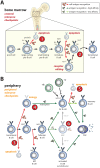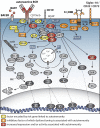Aberrant B Cell Signaling in Autoimmune Diseases
- PMID: 36359789
- PMCID: PMC9654300
- DOI: 10.3390/cells11213391
Aberrant B Cell Signaling in Autoimmune Diseases
Abstract
Aberrant B cell signaling plays a critical in role in various systemic and organ-specific autoimmune diseases. This is supported by genetic evidence by many functional studies in B cells from patients or specific animal models and by the observed efficacy of small-molecule inhibitors. In this review, we first discuss key signal transduction pathways downstream of the B cell receptor (BCR) that ensure that autoreactive B cells are removed from the repertoire or functionally silenced. We provide an overview of aberrant BCR signaling that is associated with inappropriate B cell repertoire selection and activation or survival of peripheral B cell populations and plasma cells, finally leading to autoantibody formation. Next to BCR signaling, abnormalities in other signal transduction pathways have been implicated in autoimmune disease. These include reduced activity of several phosphates that are downstream of co-inhibitory receptors on B cells and increased levels of BAFF and APRIL, which support survival of B cells and plasma cells. Importantly, pathogenic synergy of the BCR and Toll-like receptors (TLR), which can be activated by endogenous ligands, such as self-nucleic acids, has been shown to enhance autoimmunity. Finally, we will briefly discuss therapeutic strategies for autoimmune disease based on interfering with signal transduction in B cells.
Keywords: B cell; B cell receptor; Toll-like receptor; autoimmunity; kinase; receptor; signal transduction; tolerance.
Conflict of interest statement
The authors declare no conflict of interest.
Figures



References
-
- Westra H.-J., Martínez-Bonet M., Onengut-Gumuscu S., Lee A., Luo Y., Teslovich N., Worthington J., Martin J., Huizinga T., Klareskog L., et al. Fine-mapping and functional studies highlight potential causal variants for rheumatoid arthritis and type 1 diabetes. Nat. Genet. 2018;50:1366–1374. doi: 10.1038/s41588-018-0216-7. - DOI - PMC - PubMed
Publication types
MeSH terms
Substances
LinkOut - more resources
Full Text Sources
Medical
Miscellaneous

